| کد مقاله | کد نشریه | سال انتشار | مقاله انگلیسی | نسخه تمام متن |
|---|---|---|---|---|
| 4468313 | 1622314 | 2008 | 18 صفحه PDF | دانلود رایگان |

During the late Sakmarian (Early Permian), the Haushi limestone was deposited in a shallow embayment of the Neotethys Ocean covering what is now north Oman and parts of southeast Saudi Arabia. The sea persisted through the late Sakmarian, but by the time of the deposition of the ?Artinskian Middle Gharif Member, limestone deposition had ceased and generally arid fluvial and minor lacustrine palaeonvironments in a low accommodation space setting had become established. Analysis of three subsurface cored boreholes and other surface sections of the Haushi limestone shows an upward change in microfacies from bryonoderm to molechfor associations reflecting the passage from heterozoan to photozoan communities. The biotic turnover indicates cooler climate and eutrophy in the lower parts of the unit and an upward trend towards warmer climate and more oligotrophic conditions in the upper part. Common autochthonous algal palynomorphs and high δ13Corg in the lower part suggest that high nutrient levels were due to greater fluvial runoff, while allochthonous pollen assemblages indicate that the climate of the hinterland became more arid through the deposition of the unit, causing upward increasing seawater trends in δ18Ocarb. Several extraneous factors are likely to have contributed to this palaeoenvironmental change, which was more abrupt than in other parts of post glacial Early Permian Gondwana. First, the Haushi sea, being an embayment partially isolated by Hawasina rift shoulder uplift, was more vulnerable to changes in rainfall and runoff than an open sea. Second, continued post glacial global warming and small northward movement of Gondwana may have contributed to temperature increase. Aridity may have been caused by the onset of monsoons and the influence of rift shoulders to the northeast and southeast.
Journal: Palaeogeography, Palaeoclimatology, Palaeoecology - Volume 270, Issues 1–2, 1 December 2008, Pages 1–18